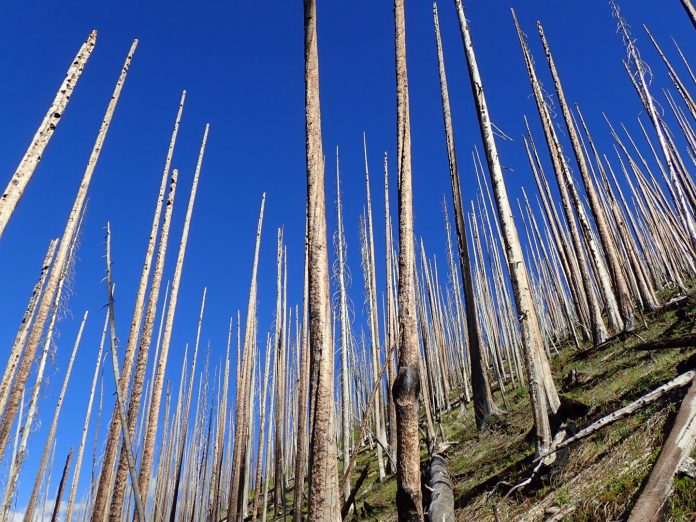IMAGE: Professor Jonathan Coop said he’s seen an incredible amount of forest lost in the Jemez Mountains where he grew up.
view more
Credit: Jonathan Coop, Western Colorado University
One of Jonathan Coop’s first vivid memories as a child was watching the flames of the 1977 La Mesa Fire in north-central New Mexico. The human-caused fire burned more than 15,000 acres of pine forests in the Bandelier National Monument and areas surrounding the Los Alamos National Laboratory.
Now a forest ecologist and professor at Western Colorado University, Coop studies the ecological effects of fire on forests in the Southwest United States. He’s also the lead author of a new scientific synthesis about how wildfires drive changes in forest vegetation across the United States. Sean Parks — research ecologist with the USDA Forest Service, Rocky Mountain Research Station — and Camille Stevens-Rumann, assistant professor in the Department of Forest and Rangeland Stewardship at Colorado State University, are co-authors of the synthesis.
“Wildfire-driven forest conversion in Western North American landscapes,” was published July 1 in BioScience.
The new paper, with contributions from more than 20 researchers, uncovers common themes that scientists are reporting, including increasing impacts of wildfires amid climate change from the borderlands of Mexico and Arizona to the boreal forests of Canada.
Following high-severity fire, scientists have found forest recovery may increasingly be compromised by lack of tree seed sources, warmer and drier post-fire climate and more frequent reburning.
“In an era of climate change and increasing wildfire activity, we really can’t count on forests to come back the way they were before the fire,” said Coop. “Under normal circumstances, forest systems have built-in resilience to disturbance – they can take a hit and bounce back. But circumstances aren’t normal anymore.”
The loss of resilience means that fire can catalyze major, lasting changes. As examples, boreal conifer forests can be converted to deciduous species, and ponderosa pine forests in the southwest may give way to oak scrub. These changes, in turn, lead to consequences for wildlife, watersheds and local economies.
‘Assisted migration’ an option in some cases, places
Researchers said that in places where the most apparent vegetation changes are occurring, such as the Southwest U.S. and in Colorado, land managers are already exploring ways to help forests adapt by planting tree species that are better suited to the emerging climatic conditions following severe fire.
“In places where changes are not quite so visible, including Montana and Idaho, those conversations are still happening,” said Stevens-Rumann. “In these large landscapes where trees are not coming back, you have to start getting creative.”
Parks, who often uses data collected in protected areas to study wildfire patterns, causes and consequences, said some fires can be good, creating openings for wildlife, helping forests rejuvenate and reducing fuel loads.
“However, some fires can result in major changes to the types of vegetation,” he said, adding that this is particularly true for high-severity wildfires when combined with the changing climate. “Giving managers information about where and how climate change and wildfires are most likely to affect forest resilience will help them develop adaptation strategies to maintain healthy ecosystems.”
Stevens-Rumann said that land managers have largely continued to operate in the way they’ve done in the past, replacing fire-killed trees with the same species. “Given the effects of climate change, we need to start being much more creative,” she said. “Let’s try something different and come up with solutions that allow natural processes to happen and interact with landscapes in different ways.”
Coop said that ecologists and managers are beginning to develop a suite of approaches to increase forest resilience in an era of accelerating change.
One approach that he said he’s partial to is allowing fires to burn under benign or moderate fire weather conditions – similar to what happens in a prescribed burn – which results in forests that are less prone to high-severity fire because of reduced fuel loads and patchy landscapes. This is also known as managing wildfire for resource objectives, an approach that researchers said is cost-efficient, allowing managers to treat more acres.
“Increasingly, we’re realizing you either have the fires you want and can influence or you’re stuck with these giant fires where, like hurricanes, there’s no shaping their path,” said Coop.
Loss of forests is personal
For many of the researchers involved in this synthesis, the issues being analyzed are personal.
Before becoming a scientist, Stevens-Rumann spent three years on a USDA Forest Service “Hotshot” crew, specializing in fighting fires in hard-to-access and dangerous terrain. Parks grew up in Colorado and California and acknowledges seeing changes in the forests and landscapes he grew up with.
Coop said he’s seen an incredible amount of forest lost in the Jemez Mountains where he grew up. The La Mesa fire was only the first in a series of increasingly large and severe fires, culminating with the 140,000-acre Las Conchas fire in 2011. Within the footprint of Las Conchas, less than a quarter of the landscape is still forested.
“Seeing these things unfold over my lifetime, I don’t know if I ever really could have imagined it,” he said. “I’ve borne witness to these very dramatic changes unfolding in the one place that I really know best on Earth.”
###
TDnews















